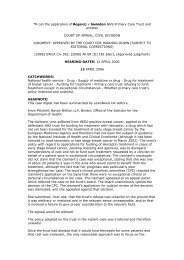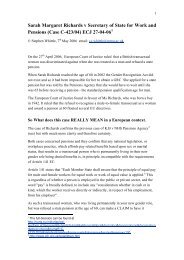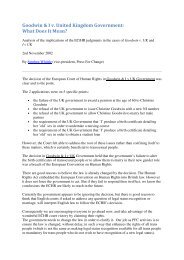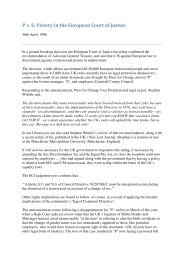Transgender EuroStudy â Legal Survey and Focus ... - ILGA Europe
Transgender EuroStudy â Legal Survey and Focus ... - ILGA Europe
Transgender EuroStudy â Legal Survey and Focus ... - ILGA Europe
You also want an ePaper? Increase the reach of your titles
YUMPU automatically turns print PDFs into web optimized ePapers that Google loves.
47 April 2008<br />
Employment Status: Chart 7 shows that over the full <strong>Europe</strong>an survey, unemployment<br />
figures appear favourable compared to the current <strong>Europe</strong>an worker experience, with figures of<br />
between 5% (trans men) <strong>and</strong> 7% (trans women) compared to an EU 27 average of 8.2%, with the low<br />
end at 3.3% [Denmark] <strong>and</strong> the high at 10.2% (Germany). 56<br />
Despite this, the numbers in paid employment are low. The current EU 27 average for all those<br />
working out of the potential working population is 64.7%, with a rate of 57.4% for women, <strong>and</strong> 72%<br />
for men (Eurostat), whereas in the respondent population only 40% of trans women <strong>and</strong> 36% of trans<br />
men are in some sort of paid employment. 57 We can guess that this community is not generally a<br />
wealthy community, with an average of 31% in full time work.<br />
In most <strong>Europe</strong>an Union countries, protection in employment for trans people only came into<br />
existence with the decision of the <strong>Europe</strong>an Court of Justice in P v S <strong>and</strong> Cornwall County Council (P v S). 58<br />
A few countries had provided protection earlier than the decision e.g. Netherl<strong>and</strong>s <strong>and</strong> Germany, but<br />
the vast majority did not. Despite the very speedy reaction of the UK’s tribunal system to this case,<br />
probably because it was a UK case, <strong>and</strong> the eventual introduction of regulatory protection, 59 we still<br />
see most EU countries, to date, having failed to formally extend legislative employment protection to<br />
trans people, relying instead on their lower court <strong>and</strong> tribunal systems to deal with claims that might<br />
arise. This may explain the statistics from this research report.<br />
Chart 7: The Employment Status of the Respondents Across <strong>Europe</strong><br />
45.0%<br />
40.0%<br />
35.0%<br />
30.0%<br />
25.0%<br />
20.0%<br />
15.0%<br />
10.0%<br />
5.0%<br />
0.0%<br />
40%<br />
38%<br />
36%<br />
Total in<br />
employment<br />
33%<br />
31%<br />
27%<br />
Working full<br />
time<br />
8% 8% 7%<br />
8% 9% 7% 7%<br />
Working part<br />
time<br />
Job Status: Percentages of All Respondents employment status<br />
Job Status: Percentages of (female to male) Trans Men employment status<br />
Job Status: Percentages of (male to female) Trans Women employment status<br />
Unemployed Student Retired Long term<br />
illness/disability<br />
<strong>and</strong> unable to<br />
work<br />
Salary <strong>and</strong> Wages: The respondents report a wide range of incomes, though they are<br />
disproportionately at the lower end of salary levels, with over one third – 37.4% – having a personal<br />
income of less than €20,000 per annum. Moreover, approximately half of trans people – 49.4% – have<br />
earnings less than €25,000, which is significant given that average earnings in the EU 27 are €28,000. 60<br />
14%<br />
3% 3% 2%<br />
4% 5% 4%<br />
5%<br />
56<br />
Source: Eurostat 18-<br />
12-2007<br />
57<br />
See the <strong>Europe</strong>an<br />
Commission website<br />
Eurostat<br />
http://epp.eurostat.ec.<br />
europa.eu.<br />
58<br />
P v S <strong>and</strong> Cornwall<br />
County Council (Case C-<br />
13/94) [1996], IRLR 347.<br />
In that decision the<br />
court clearly stated that:<br />
“In view of the objective<br />
pursued by Council<br />
Directive 76/207/EEC of<br />
9 February 1976 on the<br />
implementation of the<br />
principle of equal<br />
treatment for men <strong>and</strong><br />
women as regards<br />
access to employment,<br />
vocational training <strong>and</strong><br />
promotion, <strong>and</strong> working<br />
conditions, Article 5(1)<br />
of the Directive<br />
precludes dismissal of a<br />
transsexual for a reason<br />
related to a gender<br />
reassignment."<br />
59<br />
Sex Discrimination<br />
(Gender Reassignment)<br />
Regulations 1999.<br />
60<br />
See the <strong>Europe</strong>an<br />
Commission website<br />
Eurostat<br />
http://epp.eurostat.ec.<br />
europa.eu.








